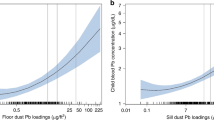Abstract
A new dust-collecting device was developed to assess surface lead loading rates in houses in communities contaminated with lead oxide dust used for caulking in nearby boat-repair yards. The device consists of two small glass sheets with total area of 1,200 cm2 placed in two plastic trays suspended from the ceiling in the house for 3 months before wiping and sending the dust specimen for determination of lead content using flame atomic absorption spectrophotometry. After a pilot trial in four households, further data were collected from 43 matched pairs of boat-caulkers’ and neighboring control households. All devices were retained in the house for 3 months without any complaint. Static measurements of lead dust levels were also assessed in all households. The values significantly discriminated high from low lead exposure households (p = 0.015) and provided good correlations with floor lead loading (Spearman rank correlation coefficient, r = 0.39 to 0.62) and dust lead content (r = 0.53 to 0.64). This sampling method is an alternative to others which consume more household space or require a longer collection period.
Similar content being viewed by others
References
Adgate, J. L., Weisel, C., Wang, Y., Rhoads, G. G., & Lioy, P. J. (1995). Lead in house dust: Relationships between exposure metrics. Environmental Research, 70, 134–147. doi:10.1006/enrs.1995.1058.
Caravanos, J., Arlene, L., & Jaeger, R. J. (2006). An exterior and interior dust deposition survey in New York City: Results of a 2-year study. Environmental Research, 100, 159–164. doi:10.1016/j.envres.2005.08.005.
Edward, R. D., Yurkow, E. J., & Lioy, P. J. (1998). Seasonal deposition of housedusts onto household surfaces. The Science of the Total Environment, 224, 69–80. doi:10.1016/S0048-9697(98)00348-9.
Gulson, B. L., Davis, J. J., Mizon, K. J., Korsch, M. J., & Bawden-Smith, J. (1995). Sources of lead in soil and dust and the use of dust fallout as sampling medium. The Science of the Total Environment, 166, 245–262. doi:10.1016/0048-9697(95)04505-U.
Hogervorst, J., Plusquin, M., Vangronsveld, J., Nawrot, T., Cuypers, A., Hecke, E. V., et al. (2007). House dust as possible route of environmental exposure to cadmium and lead in the adult general population. Environmental Research, 103, 30–37. doi:10.1016/j.envres.2006.05.009.
Hornung, R. W., & Reed, L. D. (1990). Estimation of average concentration in the presence of nondetectable values. Applied Occupational and Environmental Hygiene, 5, 46–51.
Maharachpong, N., Geater, A. F., & Chongsuvivatwong, V. (2006). Environmental and childhood lead contamination in the proximity of boat-repair yards in southern Thailand—I: Pattern and factors related to soil and household dust lead levels. Environmental Research, 101, 294–303. doi:10.1016/j.envres.2005.12.012.
Meyer, I., Heinrich, J., & Lippold, U. (1999a). Factors affecting lead cadmium and arsenic levels in house dust in a smelter town in Eastern Germany. Environmental Research, 81, 32–44. doi:10.1006/enrs.1998.3950.
Meyer, I., Heinrich, J., & Lippold, U. (1999b). Factors affecting lead and cadmium levels in house dust in industrial areas of Eastern Germany. The Science of the Total Environment, 234, 25–36. doi:10.1016/S0048-9697(99)00164-3.
National Institute for Occupational Safety and Health (NIOSH) (1994a). Manual of analytical methods 4th Ed (NMAM) 9100/1994) Lead in surface wipe sample. http://www.cdc.gov/niosh/nmam/pdfs/9100.pdf. Accessed 15 November 2006.
National Institute for Occupational Safety and Health (NIOSH) (1994b). Manual of analytical methods 4th Ed (NMAM) 7082/1994) Lead by flame AAS. www.cdc.gov/niosh/nmam/pdfs/7082.pdf. Accessed 22 January 2007.
Spalinger, S. M., von Braun, M. C., Petrosyan, V., & von Lindern, I. H. (2007). Northern Idaho house dust and soil lead levels compared to the Bunker Hill Superfund Site. Environmental Monitoring and Assessment, 130, 57–72. doi:10.1007/s10661-006-9450-z.
Thanapop, C., Geater, A. F., Robson, M. G., Phakthongsuk, P., & Viroonudomphol, D. (2007). Exposure to lead of boatyard workers in southern Thailand. Journal of Occupational Health, 49, 345–352. doi:10.1539/joh.49.345.
Trepka, M. J., Heinrich, J., Krause, C., Schulz, C., Lippold, U., Meyer, E., et al. (1997). The internal burden of lead among children in a smelter town—a small area analysis. Environmental Research, 72, 118–130. doi:10.1006/enrs.1996.3720.
U.S. Environmental Protection Agency (USEPA) (2001). Lead; identification of dangerous levels of lead. Final rule. CFR part 745. Federal Register, 66, 1211. http://www.epa.gov/fedrgstr/EPA-TOX/2001/January/Day-05/t84.pdf. Accessed 20 October 2007.
Wilson, J., Dixon, S., Galke, W., & Mclaine, P. (2007). An investigation of dust lead sampling locations and children’s blood lead levels. Journal of Exposure Analysis and Environmental Epidemiology, 17, 2–12. doi:10.1038/sj.jes.7500514.
Yiin, L., Rhoads, G. G., & Lioy, P. J. (2000). Seasonal influences on childhood lead exposure. Environmental Health Perspectives, 108, 177–182. doi:10.2307/3454518.
Author information
Authors and Affiliations
Corresponding author
Rights and permissions
About this article
Cite this article
Untimanon, O., Geater, A., Chongsuvivatwong, V. et al. Development and field trial of a household surface lead loading rate sampling device in a lead-contaminated community of southern Thailand. Environ Monit Assess 164, 379–389 (2010). https://doi.org/10.1007/s10661-009-0900-2
Received:
Accepted:
Published:
Issue Date:
DOI: https://doi.org/10.1007/s10661-009-0900-2




